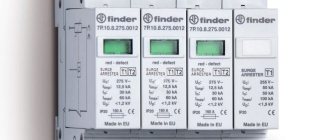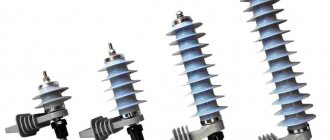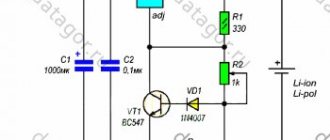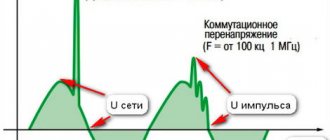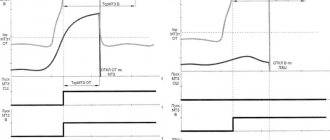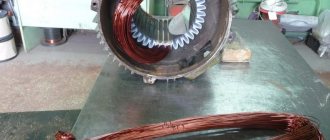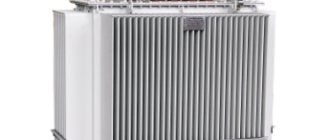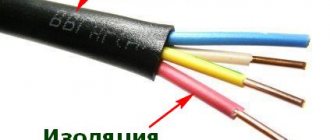Limiter protection classes
In the voltage range below 1000 V, limiters are divided into 4 classes, designated by alphabetical letters: A, B, C and D.
- Class A limiter is not used in domestic installations, but is used to protect power lines.
- Class B protector is used to protect against high voltage surges, such as those caused by lightning striking a power line.
- A Class C suppressor is designed to provide surge protection for slightly lower line voltages. Class B and C protective devices are usually installed in household switchgear.
- A class D protector is used for direct protection of selected electrical devices that are sensitive to impulse noise and surges in a 220 V network. It is mounted in a distribution panel, behind a socket in an electrical box, or directly in the protected device.
Each protection device limits the electrical potential to only a certain level. The closer the equipment is to class A, the higher the power. For example:
- Class A will reduce the voltage level to 6 kV,
- Class B will reduce the voltage level to 2.5 kV,
- Class C will reduce the voltage level to 1.5 kV,
- Class D will reduce the voltage level to 0.8 kV.
Therefore, limiters of individual classes should be used in cascade, gradually reducing the level of the maximum voltage. That is, if there is one switchgear in the house, we use both B and C class protective devices (there are 2 in 1 B + C protective devices).
If the building is multi-storey, class B protective devices should be used in the main distribution panel, and class C limiters should be used in the distribution panels in individual apartments.
If the device connected to the outlet is sensitive to voltage surges, we can also use Class D suppressors. We do not have access to Class A suppressors; this is a concern for the power company.
Since we will be looking at home wiring, the article will focus on class B and class C (types I and II) protective devices.
Device classification
The standard provides for the classification of devices according to the following parameters:
- number of inputs;
- by the method of implementing protective functions;
- by location;
- by installation method;
- by set of protective functions;
- according to the degree of protection of the outer shell;
- by the type of supply current.
This is what devices for protection against lightning and switching overvoltages look like.
Installing a surge suppressor
A standard B or C (possibly B+C) arrester consists of two components:
- Limiter base
- Replaceable insert with protective element
The basis
The base of the protective device is mounted on a TS35 DIN rail. It has two clamps. Connect the phase (L) or neutral (N) wire, which may have too much electrical potential. On the other side, connect the PE protective conductor, which is connected to the protective line of the switchgear.
The protective conductor should have a minimum cross-section of 4 mm2, but it wouldn't hurt to go larger. After all, there is a possibility that a very high current will flow.
There are 3 contacts under the PE terminal. As standard, the kit includes a plug that is inserted into the right place and allows you to connect the wires. Thanks to these clips, it is possible to remotely notify in case of damage to the insert or its burnout. This signal can be connected, for example, to the input of the alarm control unit (see diagram). In this case, the control panel will be informed that the insert is damaged by opening the electrical circuit between the red and green wires.
Insert
The insert contains all the most important elements thanks to which the defender functions correctly:
- Class B (Type I) - the main element is simply the spark gap.
- Class C (type II) - here the varistor is the main element.
How does a surge protector work?
Protection is provided by devices powered by 220V network cords connected to the arrester in the distribution box. This applies to both phase and neutral conductors (depending on the selected type of protection).
The general rule is to connect the phase conductors and possibly the neutral conductor on one side of the protective device, and the protective conductor on the other side.
When the system voltage is normal, the resistance between the wires is very high, on the order of several GigaOhms. Thanks to this, current does not flow through the arrester.
When a power surge occurs, current begins to flow through the limiter to ground.
In class B safety devices, the main element is the spark gap . During normal operation, its resistance is very high. In the case of a spark gap, this resistance is gigantic, since the spark gap is actually an open circuit. When lightning strikes a component of an electrical installation directly, the spark gap resistance drops to almost zero due to the electrical arc. Due to the appearance of a very high electrical potential in the spark gap between the previously separated elements, an electric arc is created.
Due to this, for example, a phase wire in which there is a large voltage surge and a protective wire create a short circuit and a large current flows directly to the ground, bypassing the internal electrical installation. After the discharge, the spark gap returns to its normal state - that is, it breaks the circuit.
Useful: Microwave motion sensor: circuit and connection to Arduino
A class C limiter has a varistor inside . A varistor is a specific resistor that has a very high resistance at a low electrical potential. If a voltage surge occurs in the system due to a discharge, its resistance quickly decreases causing current to flow to ground and a similar situation as in the case of a spark gap.
The difference between Class B and Class C is that the latter is capable of limiting voltage surges with a lower potential than a direct lightning strike. The disadvantage of this solution is the rather rapid wear of the varistors.
The main thing in surge suppressors, regardless of the class used, is the installation of grounding with very good parameters, that is, with very low electrical resistance. If this resistance is too high, the overvoltage current (caused by a lightning strike) can flow through the electrical system instead of the protector and leave behind burnt equipment that is currently plugged into 220-volt outlets.
Surge arrester design
Limiters of types KR, RT and VR are high-voltage devices consisting of series-connected varistors located inside an insulating housing. The safe presence of surge arresters under voltage is ensured by the highly nonlinear current-voltage characteristic of varistors. When producing limiters of voltage classes 3-10 kV, a column of resistors is located between metal electrodes and is pressed into a shell made of a special weather-resistant polymer. Limiters of the RK type consist of blocks of varistors connected in series, located inside the tire. The tire consists of a fiberglass cylinder.
Connection diagram of the limiter to the network
How to connect a limiter to a home panel? Let's start with the basics. We have a single-phase network and a single-module arrester. We want to protect the phase wire with it. Network type – TN-S.
We connect the phase power conductor directly to the arrester and connect the arrester on the other side to the PE terminal block.
But this home switch has nothing more than a surge limiter. Let's add the missing elements.
As you can see, installing a surge suppressor does not affect the further organization of components in the home switchboard. The connection of the residual current device and circuit breakers is carried out in the same way.
In general, in switchgears, surge arresters of class B, C or B + C are installed before the circuit breaker (or circuit breakers) and overcurrent fuses. But the limiter is the first element underlying the protection of a house or apartment.
What it is?
Surge surge protectors, as the name suggests, are high-voltage equipment that is designed to protect electrical devices from voltage deviations significantly exceeding the nominal values. As a rule, these strong deviations are pulsed in nature, which is why such devices are called surge voltage limiters (SVO).
Previously, valve-type arresters were used for this purpose - devices that were based on spark gap technology. Nowadays, technology has improved significantly, and now a surge suppressor, which can also be called a surge arrester, is successfully used. Only it no longer has a spark gap.
To more accurately present the whole picture, let’s consider what could be the reasons for such voltage drops.
Three-phase installation
In a three-phase circuit, the width of the limiter and the number of protected connections increase. However, the operating principle of the limiter remains unchanged. The most commonly used three-layer system protective devices operate in a 4 + 0 system, which means connecting the following lines to the arrester:
- 3 phase wires
- 1 neutral wire
Each of the wires to be protected has equal rights, that is, possible overvoltages are eliminated by supplying current to the protective installation and, as a result, to the ground.
Of course, for TN-C installations (installations without a separate protective conductor) it is possible to purchase protective devices with only 3 protected connectors. Then, from the bottom side, connect the limiter to the PEN (protection neutral) strip.
Surge suppressor parameters
Before you go to the store and buy this device, you need to know the following:
- The number of modules (terminals) depends on the type of your network. 1 module can be purchased when there is a single-phase TN-C system. 3 modules when the installation is in a three-phase TN-C network and 4 modules when the network is three-phase in TN-S or TT.
- Class (type) – you can choose between classes B, C or B + C. If you are not sure that a type B limiter is used in front of your apartment, you should choose a B + C solution. Otherwise, a type C limiter will be sufficient.
- The rated voltage at which the limiter operates.
- Uc is the operating voltage of the protector, that is, the maximum voltage level that will lead to operation.
- In is the rated current of the limiter, that is, what current can flow through the arrester in the event of a short circuit.
- Imax is the current that the arrester is capable of accepting during an atmospheric discharge. Please note that both values (In = 30,000A and Imax = 60,000A) will be relatively large in relation to the current during normal operation of appliances in the house.
- Up – the voltage to which it decreases in the event of a rupture. For example, if the potential reaches a voltage of 10,000 V in the event of a surge, the final value is reduced to 150.
Technical characteristics of arrester
Table 1 – Technical characteristics of surge arresters type 6 – 10 kV (OPN-KR/TEL–X/X UHL1(2)10/11.5)
| Name of parameters | 6/6.0 | 6/6.9 | 10/10.5 | 10/11.5 | 10/12 |
| Network voltage class, kV | 6 | 6 | 10 | 10 | 10 |
| The highest long-term permissible operating voltage Und; kV | 6.0 | 6.9 | 10.5 | 11.5 | 12.0 |
| Rated discharge current 8/20 μs, In; kA | 10 | 10 | 10 | 10 | 10 |
| Residual voltage Ures; kV; no more: | |||||
| – with a switching current pulse | |||||
| 125 A 30/60µs | 14.3 | 16.2 | 24.8 | 26.9 | 29.7 |
| 250 A 30/60µs | 14.6 | 16.5 | 25.4 | 27.6 | 30.4 |
| 500 A 30/60µs | 15.0 | 17.5 | 26.1 | 28.3 | 31.3 |
| – during a lightning current pulse | |||||
| 5000 A, 8/20µs | 17.7 | 20.0 | 30.7 | 33.3 | 36.9 |
| 10000 A, 8/20μs | 19.0 | 21.5 | 33.0 | 35.8 | 39.6 |
| 20000 A, 8/20μs | 21.2 | 24.0 | 36.7 | 39.9 | 44.1 |
| with a steep current pulse of 10000A, 1/10μs | 21.3 | 24.1 | 36.9 | 40.1 | 44.3 |
| Capacitive conduction current Iс, mA, no more: | |||||
| amplitude | 0.6 | 0.6 | 0.6 | 0.6 | 0.6 |
| effective value | 0.45 | 0.45 | 0.45 | 0.45 | 0.45 |
| Specific energy of surge arrester, kJ/kV Und, not less | 3.6 | 3.6 | 3.6 | 3.6 | 3.6 |
| Maximum current pulse amplitude 4/10 μs, kA | 100 | 100 | 100 | 100 | 100 |
| Explosion-proof short-circuit current Isk, kA | 16 | 16 | 16 | 16 | 16 |
| Maximum bending force, N | 305 | 305 | 305 | 305 | 305 |
The characteristics of surge arresters presented in Figures 5 and 6 were obtained for limiters manufactured by TEL. The “voltage-time” characteristics of 6 - 10 kV limiters of the surge arrester-KR type during the formation of quasi-stationary overvoltages is shown in Figure 5.
Figure 5 – Voltage-time characteristic: 1 – with a preliminary load of 3.6 kJ/kV Und; 2 - without preliminary energy loading.
Table 2 – Technical characteristics of surge arresters type 35 – 110 – 220 kV (OSN/TEL–X/X–550 UHL1)
| Name of parameters | 35/40.5 | 110/78 | 110/84 | 220/146 | 220/156 | 220/168 |
| Network voltage class, kV | 35 | 110 | 110 | 220 | 220 | 220 |
| The highest long-term permissible operating voltage Und; kV | 40.5 | 78 | 84 | 146 | 156 | 168 |
| Rated discharge current 8/20 μs, In; kA | 10 | 10 | 10 | 10 | 10 | 10 |
| Residual voltage Ures; kV; no more: | ||||||
| – with a switching current pulse | ||||||
| 125 A 30/60µs | 93 | 178 | 191 | 334 | 356 | 386 |
| 250 A 30/60µs | 98 | 188 | 202 | 352 | 376 | 404 |
| 500 A 30/60µs | 101 | 192 | 207 | 362 | 384 | 414 |
| – during a lightning current pulse | ||||||
| 5000 A, 8/20µs | 119 | 230 | 247 | 428 | 460 | 494 |
| 10000 A, 8/20μs | 130 | 250 | 269 | 468 | 500 | 538 |
| 20000 A, 8/20μs | 146 | 295 | 301 | 524 | 560 | 602 |
| with a steep current pulse of 10000A, 1/10μs | 153 | 295 | 317 | 552 | 590 | 634 |
| Capacitive conduction current Iс, mA, no more: | ||||||
| amplitude | 0.9 | 0.9 | 0.9 | 0.9 | 0.9 | 0.9 |
| effective value | 0.7 | 0.7 | 0.7 | 0.7 | 0.7 | 0.7 |
| Specific energy of surge arrester, kJ/kV Und, not less | 5.5 | 5.5 | 5.5 | 5.5 | 5.5 | 5.5 |
| Maximum current pulse amplitude 4/10 μs, kA | 100 | 100 | 100 | 100 | 100 | 100 |
| Explosion-proof short-circuit current Isk, kA | 30 | 30 | 30 | 30 | 30 | 30 |
| Maximum bending force, N | 580 | 600 | 600 | 640 | 640 | 640 |
The “voltage-time” characteristics of 35 – 220 kV limiters of type OPN-35,110,220 during the formation of quasi-stationary overvoltages are shown in Figure - 6.
Figure 6 – Voltage-time characteristic: 1 - with preliminary energy dissipation of 5.5 kJ/kV Und; 2 - without preliminary energy dissipation
Is it worth using a network limiter?
Every electrician wonders whether it is worth buying a surge arrester at all. After all, this is not the cheapest element of electrical installation. Theoretically, during renovation or construction of wiring from scratch in an apartment or house, the cost of 3,000 rubles (in the case of a 4-module protector) is a drop in the ocean of expenses. In practice, a protective block will not always have the opportunity to prove that it is needed. Even if it does work, voltage reduction may not always protect sensitive electronic devices (class D protection is better).
Nevertheless, the editors of 2Skhema.ru strongly recommend equipping the network with this equipment. If it protects even one valuable device, the costs will immediately pay off, and even more than that!

